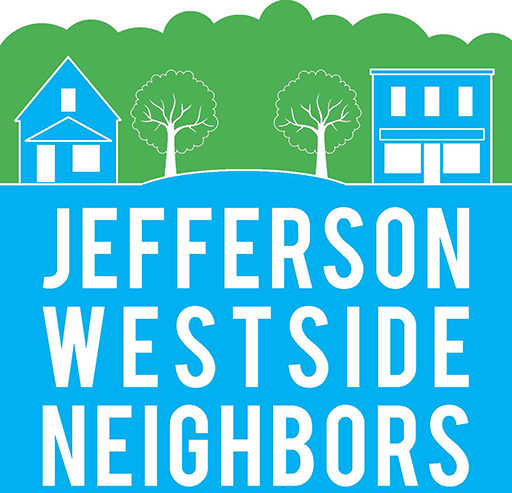Related Documents
- Jefferson Far West Refinement Plan
- Westside RefinementPlan
- Refinement Plan Process Framework DRAFT May 18
- Special_Area_Zone_Ordinance
- 2011 Jefferson Westside Neighborhood Analysis
Why Land Use and Zoning Decisions Matter
JWN Transportation Refinement Plan Process
[on hold while we look a project lead]
In 2016 the JWN membership voted on and approved the following:
Section 1. The Jefferson Westside Neighbors (JWN) opposes any future segment of EmX or other non-conventional (i.e., not regular buses) mass transit being located on a street, excepting W. 7th Ave., within or adjacent to
the area encompassed by the JWN boundaries until and unless amendments to the Westside Neighborhood Plan that address the implementation of such transit have been developed by a community-based planning process, approved by the City Council and acknowledged by the State.
This initiated a process to amend the Westside Neighborhood Plan. Such is a process is complex and involves several stages of community input. The materials below outline the process.
Refinement Plan Process Updates
Presentation on Process Design presented at the April 2017 JWN General Meeting
JWN.Refinement.Plan.Process 2 (in pdf)
Neighborhood Refinement Plans – a primer
–Jim Givens, JWN Board Member-at-Large
[Originally published in the Winter 2017 JWN Newsletter]
As the Board of Directors for the Jefferson Westside Neighbors begin work updating our neighborhood refinement plan, I thought it might be helpful to summarize a few important points about the nature of refinement plans in general, and the need now to amend our neighborhood refinement plan in particular.
All of the information for this brief summary comes from a public presentation by Paul Conte entitled “Demystifying Refinement Plans: An Introduction for Neighbors and Planners” with the permission of the author. A copy of that presentation may be found a: trusttheneighbors.files.wordpress.com/2016/04/demystifyingrefinementplansslides.pdf
A refinement plan is “a document adopted by the City Council that provides planning elements that are consistent with, but more specific than, the planning elements in the Eugene-Springfield Metropolitan Area Plan (Metro Plan).” A neighborhood refinement plan addresses:
- Land use and development
- Housing and transportation
- Public facilities and service
- Recreational needs and other subjects
A refinement plan is derived from a participatory process wherein a particular neighborhood may define goals and principles that both identify and codify ideas held in common regarding
the positive character and structure of the neighborhood, both as it exists now and regarding its growth and change in the future. Our current refinement plan dates back to 1987. To be clear, the Jefferson Westside Neighborhood has two refinement plans that have been approved by the city council: the Westside Neighborhood Plan which covers north of W. 13th Ave., and the Jefferson/Far West Refinement Plan which covers south of W. 13th Ave. We will be working on updating the Westside Neighborhood Plan. Some of the goals identified in that plan are:
- Protect and improve the residential quality of the neighborhood
- Protect the neighborhood from the negative effects of motor vehicle traffic
- Provide public facilities and services to meet the unique needs of the neighborhood
- Ensure that new development is in scale and in harmony with the existing neighborhood character
The principle elements of a refinement plan usually include, but are not limited to, the following:
- Land Use
- Neighborhood Character and Design
- Transportation and Traffic
- Public Facilities and Services
- Public Safety
- Parks and Recreation
- Economic Development
- Historical Assets
- Plan Implementation, Priorities and Updates
The structure and content of a refinement plan, in its particulars, usually takes the following form:
- Goal – “A broad statement of philosophy that describes the hopes of a community for its future. A goal may never be completely attainable but is used as a point towards which to strive”
- Objective – “An attainable target that the community attempts to reach in striving to meet a goal. An objective may also be considered as an intermediate point that will help fulfill the overall goal”
- Policy – “A statement adopted as part of the Metro Plan or other plans to provide a specific course of action moving the community toward attainment of its goals”
- Plan Diagram – Depicts allowed land uses that have the same legal status as policies
- Finding – “Factual statement resulting from investigations, analysis, or observation”
- Implementation Recommendation or Proposed Action – Non-binding recommendation
- Narrative text – Additional descriptive text
The legal effect of a refinement plan is very straightforward. For example, any amendments to the Eugene Land Use Code must not conflict with approved refinement plans. This applies to proposals for subdivisions within the neighborhood, zone changes within the neighborhood, changes to land use codes and changes to zoning standards for uses, lots, and development, or other changes that would contradict the conditions outlined in the refinement plan. The main take away here is that neighborhood refinement plans are very powerful tools!
Our first step in revising the existing Jefferson-Westside refinement plan will be to re-assess the impact of public transportation on the neighborhood. This will reflect the need to address new and alternative public transportation modes, the physical impact and frequency of bus stops and routes, and the potential impact of those items on the character and quality of our neighborhood.
